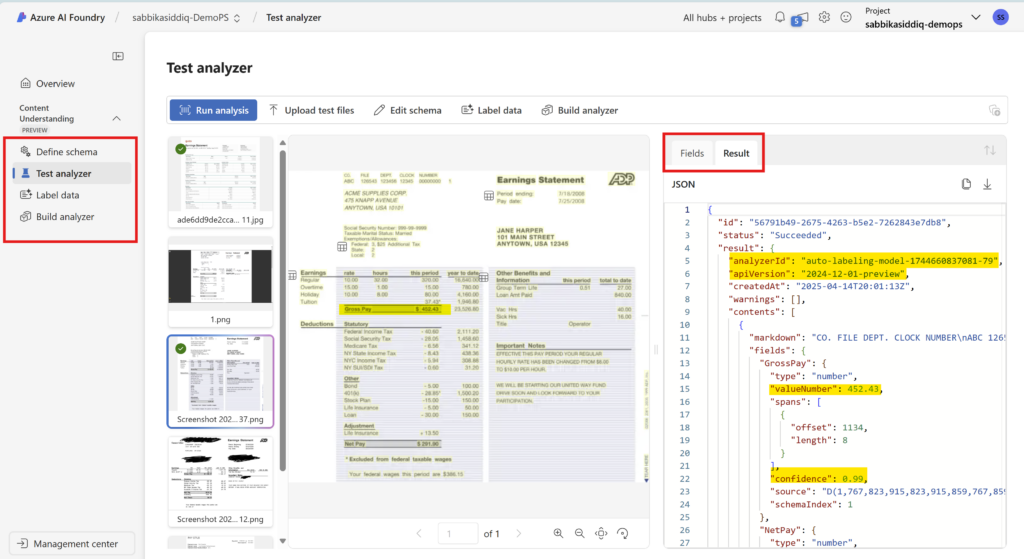In today’s digital age, organizations face the challenge of converting vast amounts of unstructured content into structured, searchable information that drives business value. This post explores how integrating Azure AI Content Understanding with Microsoft Power Pages can create powerful, intelligent web experiences that streamline operations and enhance user engagement.
What is Azure AI Content Understanding?
Azure AI Content Understanding is a cloud-based service that transforms unstructured content (documents, images, audio, video) into structured insights using generative AI. It’s currently available in preview.
Core Capabilities
- Content Extraction: Employs advanced optical character recognition (OCR) technology to convert both printed and handwritten text into machine-readable, actionable data.
- Field Extraction: Customizes data extraction according to specific business requirements using predefined or custom schemas, making it ideal for extracting key information from contracts, invoices, and other business documents.
- Add-On Features: Enhances analysis capabilities with specialized functions including layout recognition, barcode decoding, and formula identification to provide comprehensive document understanding.
- Multimodal Data Ingestion: Delivers a unified solution for processing diverse data types through an intelligent pipeline, eliminating the complexity of managing separate Azure resources for speech, vision, and document processing.
What is Power Pages?
Power Pages is a low-code platform within Microsoft Power Platform for creating secure websites for internal and external audiences. It’s built on top of Dataverse.
Common applications include customer self-service portals, partner collaboration platforms, and event registration pages—all of which can be enhanced through AI-powered capabilities.
Getting Started- Setting Up Your Environment
- Create a hub in the Azure AI Foundry portal. It requires an Azure subscription.
- Create a Content Understanding project in the AI Foundry, select the hub, provision resources, and follow the project creation wizard.
- Define analyzer templates using JSON format to structure the data extraction or by pointing and labeling.
- Configure Power Pages to communicate with Azure services through secure authentication methods.
Building a Content Analyzer in Azure AI Foundry
To create a custom content analyzer:
- Upload your sample content to Azure AI Foundry.
- Choose an appropriate template from Microsoft’s library based on your document.
- Edit the template to add your own fields and types.
- Add descriptions to your edited schema to support debugging and other developers.
- Test your analyzer against sample documents.
- Save and build your analyzer to generate endpoint URLs for your code.
The sample templates are categorized across four content types: text, image, audio, and video.

Technical Implementation Approaches
The integration can be accomplished through several methods:
- API Calls: Implement direct REST API calls to send content for analysis and receive structured data that can be displayed or stored in your Power Pages site.
- Automated Workflow Integration: Configure HTTP actions within Power Automate to parse and consume the structured data, enabling automated processing workflows.
Use Cases
- Dynamic Content Generation: Automatically generate and update web content based on document analysis.
- Enhanced Search Capabilities: Improve search functionality by indexing and tagging content.
- Form Processing and Data Extraction: Automate data extraction from submitted forms.
- Content Moderation: Analyze and moderate user-generated content.
- Personalized User Experience: Tailor content based on user interactions and preferences.
- Compliance and Legal Document Management: Extract and manage key information from legal documents.
Considerations
Review the latest MS documentationfor limitations on processing capacity, file constraints, and pricing. To get the most out of Azure Content Understanding, consider the following strategies:
- Optimize Input Quality
- Use high-resolution scans for better text extraction.
- Pre-process data to remove noise.
- Leverage Custom Models
- Train models with your datasets for better accuracy.
- Use multiple AI models for cross-validation.
- Efficient API Usage
- Batch process documents to reduce API calls.
- Monitor API usage to avoid rate limits and control costs.
- Scalability and Performance
- Adjust resources based on demand.
- Streamline workflows to reduce latency.
- Data Storage and Management
- Store data in Dataverse for easy access.
- Automate data storage and retrieval.
- Regular Updates and Maintenance
- Keep models and integrations up to date.
- Perform regular maintenance checks.
How AIS Can Help
Explore our implementation guide or learn how to integrate AI services to optimize, automate, and replace manual work. Contact AIS today—we’re here to support your AI initiatives.






